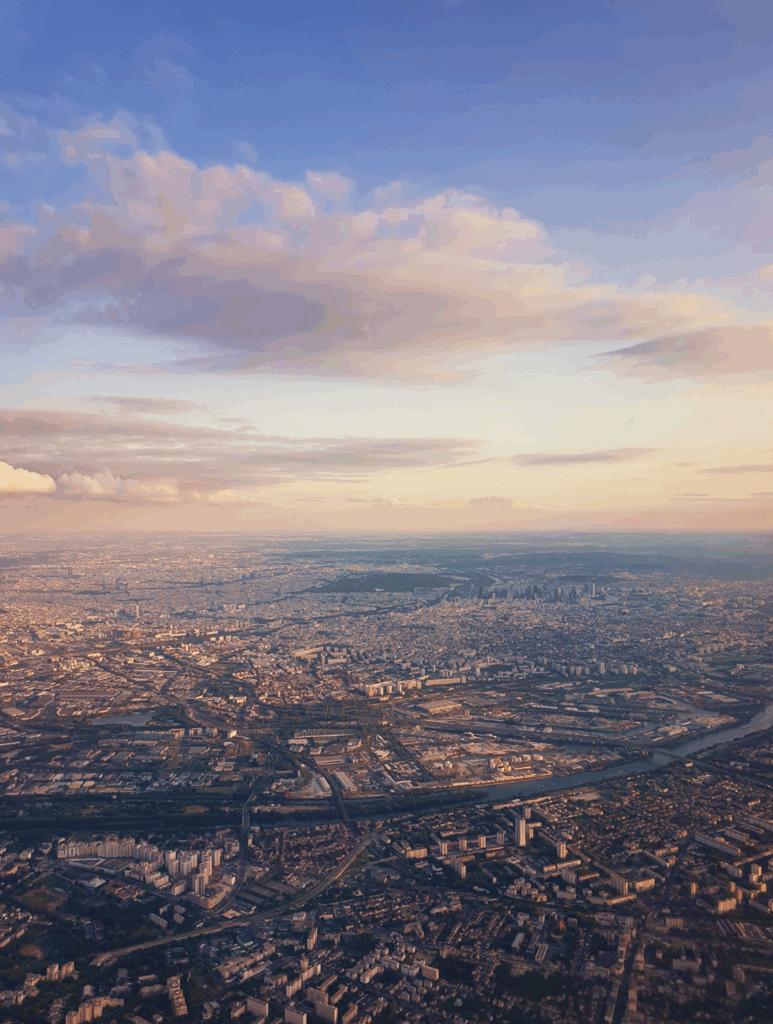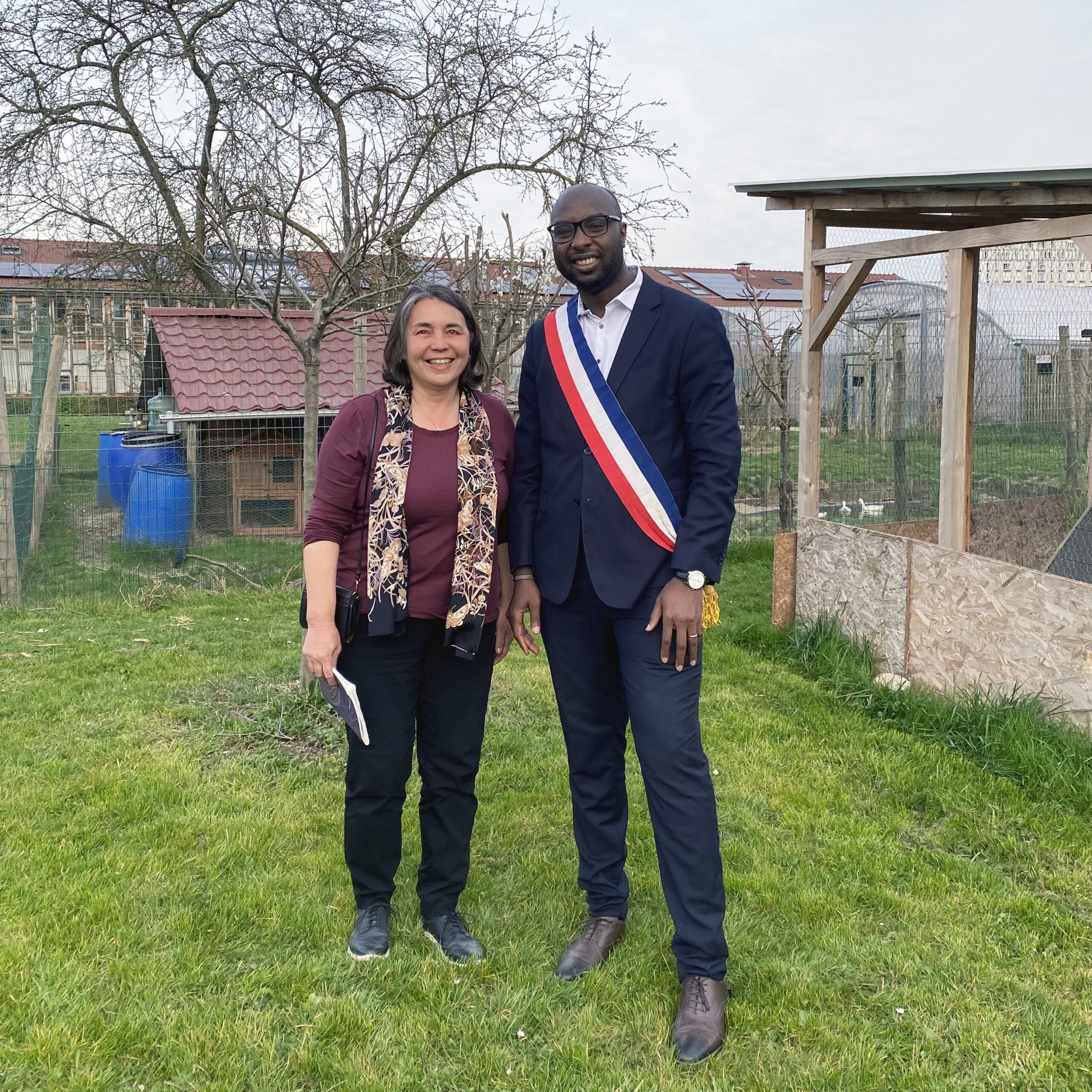An Interview with Mohamed Gnabaly, Mayor of L’Île-Saint-Denis
October 3, 2025

Aerial view of L’Île-Saint-Denis.
This past spring, SAJE Executive Director Cynthia Strathmann sat down with Mohamed Gnabaly, mayor of L’Île-Saint-Denis, a suburb of Paris with a population of around 8,300 people. An island in the Seine River historically home to a large North African immigrant community, L’Île-Saint-Denis was one of the sites of the Paris 2024 Olympic Village, much of which was newly constructed for the Games.
As mayor, Gnabaly was responsible for negotiating the terms of the Olympics Village development and mitigating further gentrification and the displacement of current residents. He worked closely with his constituents on a list of demands in exchange for agreeing to host the Village—including curbing real estate speculation, renovating the island’s dilapidated housing, and converting Olympics-related development into permanent social housing for residents after the Games were over.
(By contrast, Los Angeles’s primary development project for the formerly “no-build” Games will be a $2.6+ billion expansion to the Convention Center. Our Olympic Village will be housed in UCLA dormitories, and the Olympic-related development exemption that’s currently making its way through City Hall doesn’t do anything to incentivize the construction of public or affordable housing.)
Gnabaly spoke with Strathmann about how he worked with his community to achieve shared goals, and what lessons he learned along the way.
Cynthia Strathmann: What advice do you have for Los Angeles as we prepare to host the 2028 Olympics? How can we ensure the Games don’t displace residents or burden neighborhoods with unnecessary development?
Mohamed Gnabaly: The first piece of advice I have to give…is that mayors have a major responsibility for implementing the project, and must be the guarantors for their residents.
Developers were focused on the [Olympic] Village, but knew nothing about what was going on in the surrounding area. There was no understanding of what people were going through. They’d say to me, “We’ve got work to do to speed things up, so we’re going to cut the town in two.” So I said, “No, you can’t cut the city in half!” How would they have done that? By building a wall? With what? By putting up construction barriers and closing off the area so they could work? It’s complicated enough as it is!
But we stayed strong because we voted on it at the town council. So I came to the [negotiating] table with the voice of the people—I wasn’t the one negotiating. I had the residents’ commitments, and every time, I could fall back on the phrase: “That’s my mandate.” It’s not the mayor or the mayor’s office that speaks, it’s the residents. And that was our greatest strength, because [the Olympic organizers] didn’t really know how to manage it and were afraid for their image. Saying that we speak on behalf of the residents makes us much stronger than when we’re negotiating on an individual basis.
CS: And the people voted on a list of what they wanted?
MG: We formed a town council of residents in 2017. We consulted associations, unions, businesses, shopkeepers and parents. We consulted people and asked a very simple question: “If we have to accept the Games, what should we do for the town and its inhabitants?” And we put our responses together, and those are what we voted on at the town council meeting. That gave us strength in our negotiations, whether with the state or Paris 2024.
Then, alongside the town hall, there was a residents’ collective created by [former Mayor] Michel Bourgain called L’île Saint-Denis accueille les villages des athlètes [Saint-Denis Island Welcomes the Athletes’ Villages], which we also saw as a counterweight to both the town and its partners. We could play on the collective’s position to find an acceptable compromise.
We’re very satisfied with the project and the games, but it’s been a continuous struggle. What’s ultra important is to know why you’re doing it, and to have enough strength to keep up the struggle.
The municipality believes the games have had a very positive impact on the transformation of the city from an infrastructural point of view. They buried power lines and built a fog wall, a new foot bridge, and a noise barrier on the A86. And, in negotiating the construction of the Athletes Village, I made sure it would include the construction of new social housing.
It has also had indirect positive effects. For example, I told all the landlords, “It’s not possible for us to have a brand-new Village and for our residents to live in rotten housing. So we have to renovate everything!” And that’s why we launched the whole housing renovation program.
CS: And were there any issues with displacing existing residents? Were there any gentrification effects?
MG: We already had gentrification, but now it’s clearly accelerated. I underestimated how much this level of attractiveness would make us vulnerable to private investors. For example, the business park behind the cemetery of the Île-Saint-Denis was just bought by an American investment fund.
The clearly negative effect of gambling [on the Olympics] is the real estate speculation it generates, and the way it can worsen economic vulnerability in an area. But today we have a level of existing housing that enables us to counterbalance all the new construction. Because we have two-thirds social housing, we know that residents won’t leave. That’s what protects us.
My idea of protecting the city is to build the commons. Common assets, common infrastructures.
CS: Yeah. In L.A., we have a terrible affordable housing shortage. And it’s been made worse because of the fires.
MG: But it’s an interesting issue—to force the state and the city to find lasting solutions to the problems of fires and housing. That’s the way to look at it.
Let me give you an example: when we decided that the opening ceremony was in the Seine, and that we’re going to swim in the Seine—for me, that’s fantastic! Why’s that? It forces the state and everyone else to work on cleaning up the Seine! And that’s going to stay with us. Today, for example, several bathing sites are to be opened in Paris—and we’re working on two bathing site projects on Île-Saint-Denis.
I think Los Angeles needs to do the same with fire issues. I don’t think it’s going to be easy to manage. And the relationship between your mayor of L.A. and [President Donald] Trump is not easy, either.
CS: No, it’s terrible.
MG: Whereas here, despite our differing sensitivities, there was a sacred alliance for the Olympic Games where everyone worked together. I don’t think that’s possible in the United States.
We were happy with the impact the Games had on our local economy. We had 25% of investments mandatorily allocated to local businesses, and 10% to integration for our populations. And the construction projects provided jobs for local residents.
CS: What happened to the Saudian and Algerian migrant workers who were displaced?
MG: We had little on the Île-Saint-Denis, but it was much decried in Paris. They sent people to the shelters. It was very hard for them to get work after that, because they were scattered so far away. And, on top of that, you had to have papers to work on the construction of Olympic infrastructure.
Regardless of whether the Games are sustainable or not, the issue is that there is still a kind of invisibility of poverty in all Olympic Games, and that is a reality. We saw it. The example that really struck me was the Saint-Denis train station. I was at the Saint-Denis station earlier, and we have our kebab sellers, the guys with the skewers, cheap cigarettes, et cetera. But for two months [leading up to and during the Olympics], there was nothing.
CS: When will the real estate from the Olympic Village go on the market?
MG: It’s already on sale. We have a 160-room student residence opening in September and a hotel opening in June. I’m happy to use it again. And the first residents will arrive in October.
CS: Have rents gone up on the island?
MG: I wouldn’t say it’s had an impact on rents, but it has pushed up the sale prices of apartments, especially on older apartments in the southern part of the neighborhood. We were lucky that the financial crisis happened. It actually forced developers to lower their prices.
In the contract I signed with the developers, I capped the prices. But I was under a lot of pressure from the government. In fact, I was the only one who did it; Saint-Ouen didn’t. So I was under constant pressure from the government and developers to “Strip it down, remove the [price] ceilings, remove the ceilings!”
CS: How much is a square meter in the Olympic Village?
MG: It varies greatly from one apartment to another, but it’s around €5,500.
This differs from the north of the island, where the average is €4,000.
And there are these prices, but there are different prices for residents of the island.
CS: What did you say about the price ceiling for the–
MG: Cap, I had actually capped it at a maximum of €6,000 [per square meter].
CS: How did you do that?
MG: Because, actually, when the developers built it, they built it on public land. Here on the Île-Saint-Denis, we have a tradition of buying up land so we can negotiate back with developers. That’s why we’re not very popular with developers and investors. When you have public land management and you defend the fact that you’re on an island, you don’t let the private sector in. There’s not enough square footage!
CS: It’s a lot of work, isn’t it?
MG: It’s a job. It’s a job. It’s a job.
This conversation has been edited and condensed for clarity.
SAJE is a proud member of the NOlympics LA Coalition, organizing in opposition to the Summer 2028 Olympic and Paralympic Games and the harms they bring to working-class communities. To learn more, visit NOlympicsLA.com.

